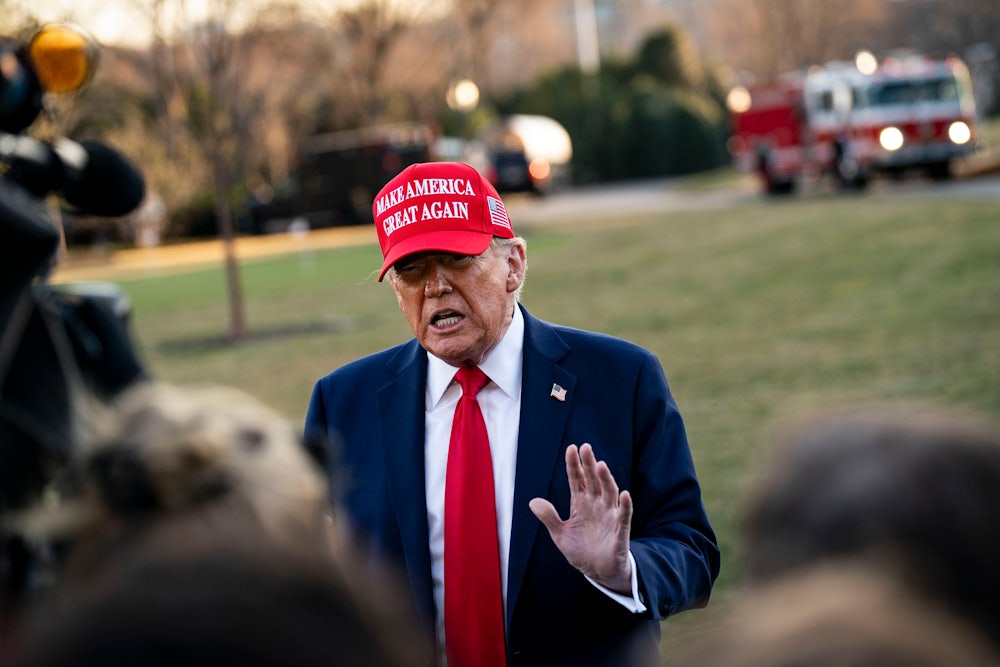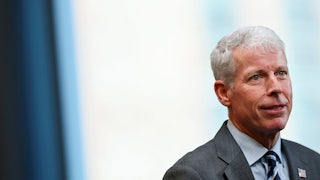Alongside tariffs, DOGE, and chaos, Trump’s thirst for “critical minerals” has quickly become one of his young administration’s defining features. Even before taking office, Trump floated the idea of invading Greenland, home to the world’s sixth-largest uranium deposits and second-largest deposits of a subset of minerals known as “rare earths.” Vice President JD Vance is set to visit later this week. Over the last several months, federal officials have pursued deals with Ukraine and the Democratic Republic of Congo promising peace and security in exchange for access to those countries’ mineral deposits. Last week, a sprawling executive order outlined a wonky list of efforts to boost domestic production of everything from lithium to gold. “It is imperative for our national security that the United States take immediate action to facilitate domestic mineral production to the maximum possible extent,” the order states, blaming “overbearing Federal regulation” for undermining homegrown extraction.
Already, two contradictions are clear in the Trump administration’s approach: First, by aggressively intervening in the private sector, Trump’s critical minerals strategy would expand rather than shrink the administrative state, as the White House has pledged to do. Second, it isn’t likely to resolve the considerable problems facing America’s fledgling critical-minerals mining sector—some of which the administration’s other policies are exacerbating.
“Unlike many of these other efforts coming out of the White House, this executive order includes a lot of really granular administrative state actions. It says we don’t just need deregulation. We also need money and institutions,” says Thea Riofrancos, strategic co-director of the Climate and Community Institute and author of the forthcoming book Extraction: The Frontiers of Green Capitalism. “DOGE is currently destroying the administrative state.”
“Critical minerals” is a term of art referring to a range of materials used in the production of everything from semiconductors to electric vehicles and missiles. While there’s no standard definition for what precisely makes a mineral “critical,” the Department of Interior has its own list of 50 minerals that it says meet the definition, last updated in 2022 and subject to review every three years. The first Trump administration amended the list in 2018 to include lithium, cobalt, and more than 30 other substances. The Biden administration’s review excluded some that had previously been included—helium, potash, and uranium—while adding others. Last week’s executive order applies to the existing list as well as uranium, copper, potash, and gold. The order empowers the recently formed National Energy Dominance Council—chaired by Interior Secretary Doug Bergum—to determine “any other element, compound or material” eligible for the kinds of support it outlines.
Though it doesn’t explicitly promise new funds, which would need to be authorized by Congress, the support the executive branch could offer might be immense. The wide-ranging order instructs government departments and agencies to conduct a rapid review of mining projects to fast-track through federal permitting processes and to expedite approvals and solicit industry feedback on “regulatory bottlenecks and other recommended strategies for expediting domestic mineral production.” It directs the interior secretary to prioritize mineral production and mining as the “primary” use for federal lands identified as having mineral deposits and reserves, “consistent with applicable law.” The order further empowers the White House to use the Defense Production Act as a means to direct federal funding capacities toward “domestic production and facilitation of strategic resources to advance domestic mineral production.” That includes funds—like those from the Export-Import Bank and Development Finance Corporation—that have traditionally been used to support investments abroad.
These sorts of actions aren’t entirely unusual. Under the control of both Republicans and Democrats, the U.S. has long gone out of its way to support extractive industries in the name of national security. It’s in line with Trump’s no-holds-barred pursuit of “energy dominance,” building on efforts during his first term to expand critical-minerals production alongside oil and gas drilling by any means necessary. This time around, though, the White House is taking a somewhat bizarre approach: While lavishing generous support on mining and refining firms to boost extraction in the name of national security, it’s also attacking predecessors’ progress toward the same goal.
The Biden administration generally expanded on the first Trump administration’s efforts to foster domestic metals and mineral supply chains as it staked out a more hawkish position on China. That country—owing to decades of investments at home and abroad, coordination across state-owned enterprise, trade controls, and planning—now refines nearly 70 percent of the world’s nickel, 40 percent of its copper, 59 percent of its lithium, and 73 percent of its cobalt, per a 2022 report from the Brookings Institution. Shortly after taking office, the Biden White House launched a review of U.S. critical mineral and material supply chain vulnerabilities. The previous administration disbursed more than $300 million through the Defense Production Act, as well, to build domestic rare earth processing capabilities, explicitly aiming to reduce U.S. reliance on China.
Biden never talked about invading Greenland, but his administration certainly wasn’t shy about exerting influence over the country’s resources. U.S. and Danish officials lobbied Tanbreez Mining—the cash-strapped company that was developing the country’s largest mineral deposit—against selling to a Chinese-owned firm. Tanbreez did eventually sell to the New York–based firm Critical Metals. That company’s third-largest investor is Cantor Fitzgerald, the brokerage firm that Howard Lutnick ran before stepping down to become Trump’s commerce secretary. The company has been in talks with defense contractors Lockheed Martin and Boeing to purchase supplies from mining operations in Greenland.
The Democratic Republic of Congo—home to some of the planet’s largest cobalt and copper reserves, as well as a brutal war—was the centerpiece of Biden’s only trip to Africa. In late 2024, he traveled there to promote the so-called Lobito Corridor, where the U.S., European Union, G7, and private firms (including Critical Metals) are spending billions on mining and infrastructure development as part of a series of partnerships with the governments of the DRC, Zambia, Tanzania and Angola. The initiative is a bid to compete with China, whose firms control more than two-thirds of the country’s copper and cobalt mining operations as a result of long-standing investments and infrastructure spending. Trump has taken a less multilateral approach in looking to negotiate a security-for-minerals deal championed by Congolese President Felix Tshisekedi. And rather than embarking as Biden did on a partnership for minerals with Canada—home to some of the world’s largest mining conglomerates—Trump has threatened to make Canada the fifty-first state.
Charitably speaking, the Trump administration is focusing more on what are known as the upstream parts of the minerals supply chain (i.e., mining and refining) than Biden, whose White House emphasized investments further downstream, in areas like battery manufacturing and recycling. The Inflation Reduction Act, CHIPS and Science Act, and Infrastructure Investment and Jobs Act—which Trump and fellow Republicans have vowed to scrap—subsidized exploration, extraction, and processing along with the production of lithium-ion batteries, solar panels, and other technologies that require critical minerals, plus infrastructure to support that manufacturing and increase the adoption of electric vehicles. Though Biden often spoke about the importance of those technologies for fighting climate change, his administration was just as explicit about supporting such investment as a means of eroding China’s global dominance in these sectors. Last September, the White House boasted in a fact sheet that companies had announced more than $120 billion worth of investments in battery and critical-minerals supply chains since Biden took office, and claimed that the U.S. was on track to supply more than one-fifth of global demand outside of China by 2030. “After years of ceding ground to China,” the fact sheet argues, “we are now winning the competition for the 21st Century, protecting our industrial base and creating good jobs, and strengthening our energy and national security.”
Trump’s more guns-blazing approach to securing minerals means that the administration could find itself caught in a web of contradictions. The trade war he’s stoking with China, and longtime allies like Mexico, Canada, and the European Union, threatens to drive up already inflated production costs for upstart domestic mining companies struggling to court investors. That hostility is also encouraging foreign governments to safeguard their own access to those resources, providing the small handful of firms that dominate mineral supply chains with other, potentially more reliable investment options abroad.
“Miners and the refiners are in a really bad way right now,” says Chris Berry, an independent analyst focused on battery metals supply chains. Among the core challenges are the fact that “metals prices are too low to justify investment,” he told me, and that “the cost of building a mine or refinery has exploded” over the last several years, thanks to rising interest rates and production costs. While these dynamics are a problem for companies that already dominate the market for many so-called critical minerals—most of which are headquartered in Asia, and many in China—U.S. firms looking to break into mining and refining lack experience and relationships with buyers. Given just how far the U.S. lags behind its international competitors in mining and refining those materials, taking a sledgehammer to government R&D via indiscriminate DOGE cuts won’t help, either.
The White House’s pledge to nuke many existing subsidies aimed at boosting the consumption of critical minerals threatens to dry up critical sources of domestic demand, frustrating U.S. extractive firms’ efforts to ink the kinds of supply deals with manufacturers that can assure investors they won’t be wasting their money. “He definitely wants to reduce trade imbalances around resources. He seems less interested in what the resources are used for,” Riofrancos says of Trump. “He just really doesn’t explain why particular resources are important. I’m not sure if that’s the limits of his brain, or the fact that he wants more mining and doesn’t care about the end uses.”
The military contractors and artificial intelligence developers in Trump’s orbit are plenty hungry for minerals in some general sense, and Riofrancos notes that a focus on mining is something of a “crowd pleaser” for various arms of the Trumpist coalition: from economic nationalists who want to reduce trade imbalances and Make America Great Again to Silicon Valley titans eager for chips and cheap energy to power data centers. But the U.S. is a long way off from being able to extract, process, and sell the materials the White House wants at a scale that would make it a critical-minerals superpower. Whereas the U.S. accounted for roughly a third of global lithium production in 1995, it produced just 1 percent as of 2021. Between 2013 and 2020, by contrast, China expanded its lithium processing capacity sevenfold, compared to a 10 percent expansion in the rest of the world.
Bluster and resource grabs and executive orders can’t wish away that gap. “I don’t think that we’re going to be able to—never mind beat the Chinese—but I don’t know if we’re going to be able to catch up,” Berry says. “We’re very sensitive here to low metals prices and [capital expenditure] and returns. They’re not worried about quarterly earnings statements. They’ve said that in five years or 10 years, we want to dominate rare earths, or lithium. We’re bellyaching, saying, ‘What do you mean it costs $1 billion and five years to build that?’ But that’s what it costs, and that’s what it takes.”








